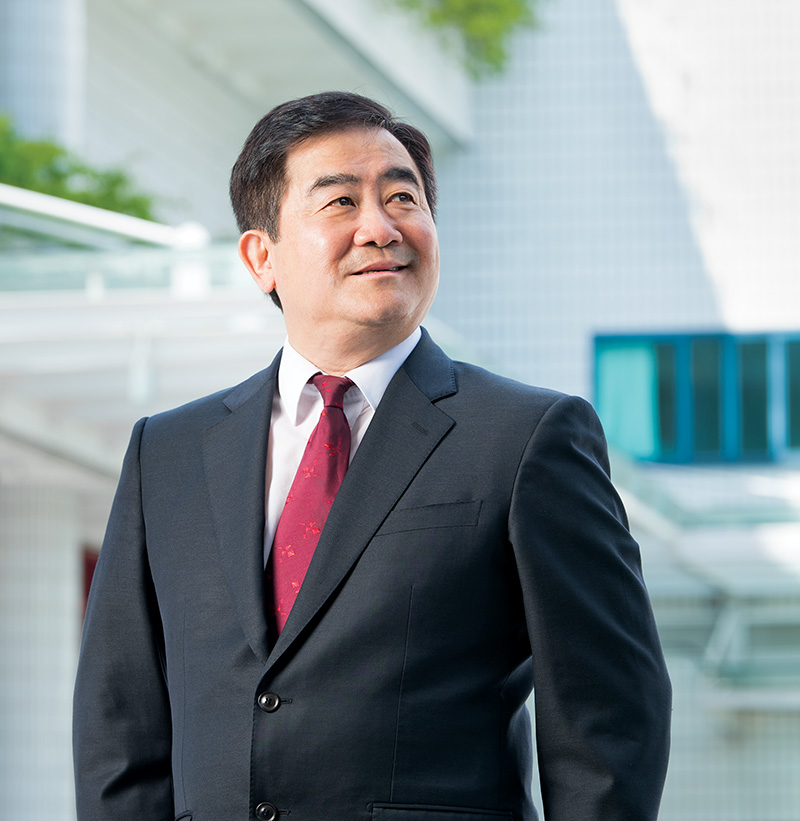
European hat trick
By : Catherine Law
The European Academy of Sciences (EurASc) is a major hub for outstanding scientists, including since its founding more than 15 years ago Nobel Laureates and Fields Medal winners.
So, it is with great pride that three CityU scholars were elected Fellows in recognition of their enormous contributions to science. Their success demonstrates the world-class quality of our research and scholarship in the sciences.
The three academics are Professor Alex Jen Kwan-yue, Provost and Chair Professor of Chemistry and Materials Science; Professor Felipe Cucker, Head and Chair Professor, and Professor Yang Tong, Chair Professor, both from the Department of Mathematics.
Interdisciplinary research
 Professor Alex Jen Kwan-yue Professor Jen has been recognised by EurASc for his profound contributions to research on science and technology, in particular in the area of materials science. He is among the pioneers who promote interdisciplinary research that directly benefits society. Professor Jen has co-authored more than 870 publications, given over 550 invited presentations, and has more than 49,500 citations and an H-index of 113. He is also the co-inventor for more than 60 patents and invention disclosures, many of which are now commercial applications.
Professor Alex Jen Kwan-yue Professor Jen has been recognised by EurASc for his profound contributions to research on science and technology, in particular in the area of materials science. He is among the pioneers who promote interdisciplinary research that directly benefits society. Professor Jen has co-authored more than 870 publications, given over 550 invited presentations, and has more than 49,500 citations and an H-index of 113. He is also the co-inventor for more than 60 patents and invention disclosures, many of which are now commercial applications.
“I feel excited to be recognised by EurASc,” he said. “It has a very broad membership. A lot of Nobel Laureates and Fields Medal winners are among its members. I am very honoured to be associated with such a highly distinguished group of scientists.”
Professor Jen’s research is interdisciplinary. He specialises in organic/hybrid functional materials and devices for photonics, electronics, renewable energy, ultra-fast information processing, and nanomedicine.
He started to promote interdisciplinary research almost four decades ago. “At the time when I studied for my PhD, every discipline was very isolated, which hindered the progress for research. At that time, I made up my mind to get involved in an interdisciplinary area, to act as a bridge between physics, chemistry and engineering to connect different disciplines and create a collective impact,” recalled Professor Jen.
For his pioneering contributions in organic photonics and electronics, Professor Jen has been recognised by various professional societies as Fellow, including the American Association for the Advancement of Science, Materials Research Society, American Chemical Society, Division of Polymeric Materials: Science and Engineering, The Optical Society and SPIE, the International Society for Optics and Photonics.
Creative, mathematical
Professor Cucker, who joined CityU 22 years ago, is best known in his field for the Cucker-Smale flocking model, a pioneering mathematical model on how birds adopt a common velocity when flying. It shows that under some conditions that can be expressed in terms of initial velocities and positions this common velocity is eventually reached. The model has received widespread attention from applied mathematics and control engineering communities around the world.
“It is an honour to be elected. I was surprised because I was not expecting it at all,” said Professor Cucker, whose main research focus is the foundational aspects of numerical algorithms. His recent research has included areas such as learning theory and mathematical modelling for the evolution of human language.
 Professor Felipe Cucker (left) and Professor Yang Tong. Professor Cucker’s passion for mathematics has inspired his students and has greatly contributed to the overall study of mathematics. What’s more, as an avid art lover, he has planted the seeds of mathematics in the creative domain. His course “Art and Mathematics” discusses the mathematical nature of the rules of art such as for the symmetry found in painting and counterpoint in Bach’s music.
Professor Felipe Cucker (left) and Professor Yang Tong. Professor Cucker’s passion for mathematics has inspired his students and has greatly contributed to the overall study of mathematics. What’s more, as an avid art lover, he has planted the seeds of mathematics in the creative domain. His course “Art and Mathematics” discusses the mathematical nature of the rules of art such as for the symmetry found in painting and counterpoint in Bach’s music.
Professor Cucker published a book Manifold Mirrors: The Crossing Paths of the Arts and Mathematics in 2013, and in 2016 he paired up with digital artist Dr Hector Rodriguez of CityU’s School of Creative Media to create a new media artwork using sets of prints and videos that visualise the Theory of Approximation. The artwork made an impact globally and was exhibited in Europe.
Searching for the proof
Working in partial differential equations and kinetic theories, Professor Yang is well known in the area of hyperbolic conservation laws. In 1999, Professor Yang, together with Stanford University’s Professor Liu Taiping, constructed the “Liu-Yang functional”, which established the theory and stability of hyperbolic conservation laws in one-dimension.
“I feel privileged to be part of the Academy. It is great recognition for my work,” he said, noting that he was grateful for CityU’s support. “CityU emphasises research and recognises efforts made, which creates a positive environment.”
Prandtl’s boundary layer theory is Professor Yang’s latest research area. Developed in 1904 and widely applied in physics and engineering in the field of aerodynamics, this important advance in fluid dynamics still lacks a mathematical proof. Professor Yang’s objective is to prove this theory mathematically, and then develop it within a 3D context.
Though mathematics can be expressed in equations and models, the initial research with most mathematics-related topics requires early work to be carried out inside the imaginative minds of the mathematicians themselves. For this practice to be successful, Professor Yang said that mathematicians ought to be focused, independent, and persistent in their area of special interest.


